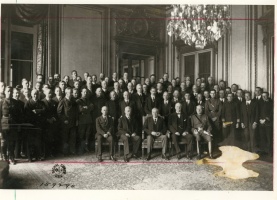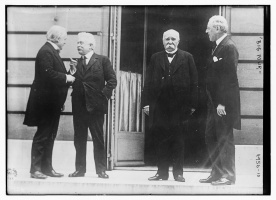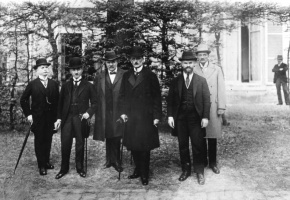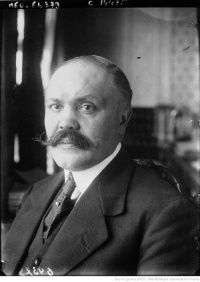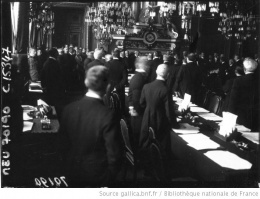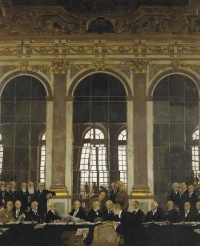Introduction↑
When French President Raymond Poincaré (1860-1934) opened the Paris Peace Conference on 18 January 1919, he recalled in his speech that it was precisely on this day in 1871 that the German Empire had been proclaimed in the Hall of Mirrors at the Palace of Versailles, and that this empire then soon became the first to rob France of two provinces. For Poincaré, the empire had been rotten from its very beginnings and carried within it the seed of death due to the error of its founders; born in injustice, it was now lost in disgrace.[1] Although the Paris Peace Conference did not begin on that day intentionally (the Italian delegates had arrived late),[2] the date offered the opportunity to accuse and humiliate the absent Germans. Convinced of the German Empire’s responsibility for the war, those representing the victorious states refused to negotiate with the Germans in person. The Allies and Associated Powers were deeply convinced of German guilt in and of the war. They feared that talks with the defeated might suggest that the question of guilt had not yet been finally settled. In addition, however, they feared the force of opposing arguments on individual delegates. The fear that the victors' camp could be divided was great and – as it turned out – quite realistic. The conviction of German guilt created a narrow and fragile bond that held the victorious powers together in spite of all their conflicting interests. The German delegation was only invited to Paris at the end of April, and the draft treaty was handed over on 7 May. The victorious powers still refused to enter into direct negotiations with the German delegates, and therefore an intensive exchange of written notes ensued. These only lead to minimal changes.
However, the speech given by German Foreign Minister Ulrich von Brockdorff-Rantzau (1869-1928) at the handover of the treaty on 7 May 1919 caused indignation among the victorious powers and led them to formulating Germany’s war guilt even more sharply. The German National Assembly only unconditionally approved the signing of the treaty shortly before the ultimatum would have expired. The government had resigned in the preceding discussion, and Brockdorff-Rantzau also felt unable to sign the treaty. Therefore, on 28 June 1919, Foreign Minister Hermann Müller (1876-1931) (SPD) and Transport Minister Johannes Bell (1868-1949) (Centre Party) signed the treaty, which contained 440 articles in fifteen parts. The treaty was ratified by the National Assembly on 9 July 1919, published in three languages in the Reichsgesetzblatt on 16 July 1919, and came into force on 10 January 1920, after it had been ratified by France, Great Britain and Italy.[3]
The Text of the Treaty↑
Initiated primarily by the American President Woodrow Wilson (1856-1924), the League of Nations covenant in part 1 of the treaty was particularly ground-breaking. Wilson’s hope was that conflicts would be resolved peacefully in the future, and he firmly believed that the League of Nations would be able to address any possible shortcomings of the peace treaty. The defeated nations were not immediately members of the League of Nations, even though its covenant was part of the peace treaties. The League of Nations formally came into being on 10 January 1920 and was dissolved on 19 April 1946, one year after the founding of the United Nations. Its aim was primarily to use collective means to preserve the territorial integrity and political independence of a state against external aggression (article 10). Members of the league committed themselves to the full and frank exchange of all information on the scale of their armaments, their military, naval, and air programmes, as well as of their war industry (article 8).
Part 13 was also unusual for a peace treaty, since it reflected the desire to create a better and fairer world. Its opening sentence argues that “such peace can be established only if it is based upon social justice”. Justice should be achieved by, among other things, regulating hours of work, establishing a maximum working day and week, and protecting workers, children, young people and women. The partners to the treaty created the International Labour Organization (ILO), which still exists today, with Germany being allowed to join immediately.
Parts 2 and 3 (Germany’s boundaries and political clauses for Europe) were particularly controversial in Germany. They determined the areas that Germany had to cede (Alsace-Lorraine, Eupen-Malmedy), possibly temporarily (Saar area) or after a referendum (Schleswig, Upper Silesia, small parts of East and West Prussia). All in all, Germany lost one eighth of its national territory and thus one tenth of its population (some of non-German nationality), 15 percent of its agricultural production (grain), 50 percent of its iron ore supply, and 25 percent of its hard coal production.[4] Part 2 prohibited Germany and Austria from merging – however, the League of Nations could have revised this decision at the request of both states. The borders of states newly established or re-established (Czechoslovak Republic, Poland) in part 3 led to competing territorial claims and some bloody battles in the years to come.
In part 4, Germany relinquished its colonies, with fierce arguments breaking out as to whether they should remain in the camp of the victors. It was finally agreed to subordinate the colonies (including Togo, Cameroon, Namibia, Tanzania, Burundi and Rwanda) as a mandate of the interested powers for a long period of time – and formally under the supervision of the League of Nations. The right of self-determination propagated in Wilson’s fourteen points was not considered. In the long term, however, the mandate system represented an important stage on the road to decolonization.[5]
Part 5 limited the total strength of the army to 100,000 men (including 4,000 officers). The import of weapons and armoured cars was banned, as was the production and import of poisonous gases. General conscription was also abolished. The number of training schools for officers was limited. Warriors', marksmen's, sports, or hiking clubs were not allowed to engage in military matters. The German Reich was only allowed to own six ships of the line, six small cruisers, twelve destroyers and twelve torpedo boats; submarines were forbidden. The Kriegsmarine was not allowed to exceed 15,000 men, including a maximum of 1,500 officers and deck officers. Germany was only allowed to maintain 100 seaplanes or flying boats. The personnel – including officers – was limited to 1,000 men. Germany was not allowed to maintain an air force.
These regulations were clearly aimed at ensuring that Germany could no longer wage a war of aggression in the future. At the same time, though, it should be able – without relying on the support of the victorious powers – to use the army internally against insurrections and to protect its borders.
The penalties specified in part 7 were also viewed with horror by the German population. Article 227 stated that Wilhelm II, German Emperor (1859-1941) was to be brought before a tribunal yet to be constituted. It had not been customary up until then for members of a state to be held personally responsible for war crimes. On the contrary: in modern times, it was considered the right of the head of state to wage war. Taking up arms was an accepted form of exercising power. During the First World War, the perception of the law slowly changed; in Paris, there was controversial debate about such retroactively created offences. Wilhelm II was considered by the Allies to be the main culprit for unleashing the war. The jurists were well aware of how delicate this accusation was. It violated the principle that a conviction could only be based on laws that were valid at the time of the crime. International law, however, at that time knew neither individual responsibility for political acts nor the responsibility of heads of state. Nevertheless, the peacemakers argued, the guilt was so enormous that they could not simply move on and forget about it. Politicians and military leaders were held accountable for the first time after the Second World War in the war crimes trials in Nuremberg and Tokyo. Articles 228 and 229 specified that persons who had violated the laws and customs of war had to answer before a military tribunal. The victorious powers agreed that the proceedings could take place in Germany, and they did so before the highest German court, the Reichsgericht in Leipzig, between January 1921 and November 1922. Although only a handful of judgments were handed down, and more than 1,700 trials were discontinued, the judges did endeavour (often against their own beliefs) to run the proceedings in an open and unbiased manner.[6]
After the Germans had already committed themselves by signing the armistice agreements to release the Allied prisoners of war immediately, part 6 of the treaty now also instructed the victorious powers to release German prisoners of war and civilians. The parties to the treaty gave reciprocal recognition to the respective war grave organizations and assured them of their support by handing over lists of names, etc. Support would also be given to transferring the remains of those killed in action.
The most well-known and controversial section of the Treaty of Versailles is undoubtedly part 8, which begins with article 231:
This article can be read as a kind of compromise: In view of the conviction of the victorious powers that Germany was at least responsible for the unleashing of the war in the July crisis, it seemed to them of great importance to stipulate (and to have Germany acknowledge, as it says in the article) that it assumed this responsibility with all the resulting costs. With this formulation, the Allies, who were aware – to varying degrees – that Germany would not be able to assume all the war costs, saved face, kept their election promises, and could later generously waive a large part of the sum to which they were entitled. This compromise brought to an end a debate in the Reparations Committee that was essentially about whether or not the armistice conditions and the Allies' agreement on the fourteen points set limits on reparations claims. In other words, whether Germany would only have to pay for the costs incurred by the invasion of Belgium and the occupation of the northern French departments, which was contrary to international law, or whether all the war costs of the victorious powers, up to and including the pensions of veterans and surviving dependents, would have to be paid. Incidentally, the sharp formulation of the war debt in the Mantelnote handed over to the Germans on 16 June 1919 is not part of the treaty, so does not appear in the text of the treaty and later the law.
How extensive the reparations payments would be was already indicated by the remarks following article 231. The exact amount of reparations was to be determined by an Allied commission (Wiedergutmachungskommission) no later than 1 May 1921 (article 233). The total would include all the damage caused to the civilian population in each of the Allied and Associated countries since the beginning of the state of war. In the case of Belgium, the loans the country had taken out up to 11 November 1918 also counted as damage, and Germany undertook to repay the total amount plus 5 percent interest (article 232). Annexes I, III and IV specified which damage was to be repaid: this included destruction inflicted on civilians by acts of war. Not only the victims themselves, but also their surviving dependants were entitled to reparations. All objects that had been confiscated, used, or damaged by the Germans or that had been destroyed as a direct result of the acts of war were included in the bill. This also included a claim for a single tool. All of these destroyed items, which included livestock, could be replaced with objects of equal value that originated in Germany at the request of the Allies. Article 231 had the function of determining the principle of Germany’s global obligations regarding reparations. The article enshrined the legal liability for the damage caused and secured the claim for reparation legally. In Paris, the victors could not agree on the amount of reparations to be paid for fear of either demanding too much of Germany or treating it too leniently. It was only in January 1921 that the Allied Reparations Commission specified the sum of the payments demanded. Germany itself had offered 100 billion gold marks, but in fact it paid about 20 billion in reparations.[7] In Germany, reparations obligations were effectively portrayed as the cause of economic problems. However, large loans which Germany received from the United States in the 1920s – and only repaid to a small extent – exceeded the payments that Germany made to the victorious powers.[8] The annexes in this part of the treaty show how intense discussions were in Paris about the consequences of the total war – for example, in connection with the question of what could be described as damage at all.
Further regulations concerned the retroactive maintenance of the Allied and Associated Powers’ armies in the occupied German territories back to the day of the armistice. All costs were to be borne by the German Empire (part 9, article 249 and article 251). Until the planned announcement of the final reparation sum in May 1921, the German government was forbidden to export or dispose of gold without the previous approval of the victorious forces (article 248). A most-favoured-nation clause (part 10) was to apply until 1923. Germany was thus obliged to grant trade advantages from which one partner benefited to all partners to the treaty. Customs duties levied by the empire and any fees for the import, export and transit of goods had to be the same for all trading partners (articles 264-267 and 269). The Allied and Associated Powers were permitted to apply a special customs regime for imports and exports to the German territory occupied by their troops (article 270). They were thus able to establish a customs border on the Rhine, which favoured the import of foreign goods and made the export of German products more expensive.
Parts 11 and 12 stipulated that aircraft of the Allied and Associated Powers were allowed to fly over Germany and land on its soil and territorial waters until 1 January 1923. Germany also undertook to allow the Allied and Associated Powers free transit through its territory on transport routes suitable for international traffic. Navigable rivers, canals and railways were thus made accessible without customs duties or delays (article 321). The Treaty of Versailles provided inland navigation for such a European order that gave access not only to the immediate neighbouring states, but also to Switzerland, Belgium, Italy, and Great Britain. In fact, an international order for rivers was not an innovation of the peace treaty, as there had been such agreements for the Danube and the Rhine since the 19th century, with the Central Commission for Navigation on the Rhine (CCNR) having been established by the Mannheim Act of 1868. The CCNR retained supranational jurisdiction and thus acted like a state.[9]
The penultimate part, part 14, ensured the execution of the provisions agreed in the treaty. As it turned out, non-compliance with deadlines led to two major clashes, in 1921 and between 1923 and 1925. If the conditions were met by the Germans, article 429 promised that the occupied territories would be cleared in fifteen years, in five-year increments. Article 431 promised the immediate withdrawal of the occupying troops, i.e. the troops of the Allied and Associated Powers occupying the Rhineland, if Germany fulfilled its duties before the expiration of the period of fifteen years. Should the security needs of the victors not be met at the end of this period, the article also allowed for an extension of the occupation. Article 433 confirmed the repeal of the Treaty of Brest-Litovsk. In part 15, Germany undertook to recognize the arrangements regarding the territories that the Allies and Associated Powers had agreed on with Germany’s former allies (Austria-Hungary, Romania, and the Ottoman Empire). The newly created states were also recognized by Germany (article 434).
Evaluation of the Treaty↑
The historian Michael Salewski (1938-2010) stressed in 1980 that it was not only German foreign policy in the years of the Weimar Republic that was shaped by the goal of revising the provisions of the treaty, but that the struggle against Versailles was also the domestic theme that united all social and political groups. Salewski spoke of a syndrome, of a clinical picture that had infected the entire society.[10] The legitimacy of the Treaty of Versailles as a verdict of guilt passed by the Allies against Germany was not recognized by any political camp.
But historians were also silent at first, even though or because many had been front-line soldiers themselves, and initially they did not reflect publicly on their own war experiences. The majority were opposed to the new political order and devoted themselves to a moralizing discussion of innocence. Only in the wake of the gradual revision of the Treaty of Versailles by the National Socialists did they break their silence and welcome the reintroduction of compulsory military service (1935), the annexation of Austria (1938), and finally the victories over Belgium and France in 1940.[11]
In the literature, the Treaty of Versailles is still controversially discussed today.[12] However, the tenor of the publications of the past three decades is more "matter of fact", which may be due to the fact that the First World War is no longer analysed only from the perspective of the history of the Second World War. Not only Charles de Gaulle (1890-1970) or Winston Churchill (1874-1965), but also historians like Pierre Grosser or philosopher Raymond Aron (1905-1983) have linked the two wars into a Thirty Years' War.[13] In this way, the peace treaty, which could not establish a stable peace order, was virtually blamed for the ensuing world war. With greater temporal distance – especially since 1989 – both conflicts have been analysed more strongly with a view to their respective particularities. Thus, the 1920s are increasingly coming into the focus of research and the interwar period is no longer treated solely with a view to the failure of efforts to establish a stable peace order. ”All misfortunes of the 1930s are not the consequences of the treaty“, argues the French historian Georges-Henri Soutou.[14] Thus, the treaty is neither judged as an overly harsh Carthaginian peace nor as inevitably possible. Historians highlight the achievement of signing a peace treaty in Paris as the result of a manifold willingness to compromise.
The extensive research on the First World War has revealed the extent of the destruction on the states involved down to the level of individuals. With the analysis of the violence, the challenge of creating a lasting peace is also seen as more difficult. The situation in southeastern Europe is one of the contributing factors that made the situation in Europe very fragile. From this perspective, the continuation of violence is not interpreted as a failure of the peace treaty, but also finds causes and responsibility in the policies of the newly created states.[15]
The research draws attention to the diverging interests of France and Great Britain – after the phase of cooperation in the war years. France's need for security plays a major role in research, but the policy is now interpreted as more flexible and more willing to compromise.[16] Locarno is interpreted by British historian Alan J. P. Taylor (1906-1990) as the actual end of World War I.[17] By not only focusing on the 1930s in the literature but also including the 1920s, the question of whether the Treaty of Versailles is to blame for World War II is now answered in a more nuanced way. However, not everyone goes as far as the Canadian historian Margaret MacMillan: she stresses that, from a propaganda point of view, the treaty was a gift of God for Adolf Hitler (1889-1945). She argues that the peacemakers did not succeed in decisively weakening Germany. With a stronger democracy in Germany and without the devastation of the global economic crisis, history might have been different: “The Treaty of Versailles is not to blame. It was never consistently enforced […]”.[18] The question of whether the peace treaty failed because it punished Germany too harshly or not harshly enough is still controversial among historians today.
Susanne Brandt, Heinrich-Heine-Universität Düsseldorf
Section Editor: Christoph Jahr
Notes
- ↑ See Le Figaro, 19 January 1919.
- ↑ Secretary’s Notes of a Conversation Held in M. Pichon’s Room at the Quai d’Orsay on Monday, January 13, 1919, at 4 p.m., in: Papers Relating to the Foreign Relations of the United States, the Paris Peace Conference, 1919, Vol. 3, Document 26, pp. 531-538, online: https://history.state.gov/historicaldocuments/frus1919Parisv03/d26 (retrieved: 14 July 2021).
- ↑ Gesetz über den Friedensschluß zwischen Deutschland und den alliierten und assoziierten Mächten, in: Reichs-Gesetzblatt, No. 140, 16 July 1919, pp. 687-1349. See Deutsches Reichsgesetzblatt Teil I 1867-1945, issued by Österreichische Nationalbibliothek, online: http://alex.onb.ac.at/cgi-content/alex?aid=dra&datum=19190004&seite=00000687 (retrieved: 24 June 2021).
- ↑ Kolb, Eberhard: Der Frieden von Versailles, Munich 2005, pp. 63-64.
- ↑ Zimmerer, Jürgen: Von der Bevormundung zur Selbstbestimmung. Die Pariser Friedenskonferenz und ihre Auswirkungen auf die britische Kolonialherrschaft im südlichen Afrika, in: Krumeich, Gerd (ed.): Versailles 1919. Ziele – Wirkung – Wahrnehmung, Essen 2001, pp. 145-158, here pp. 146, 152.
- ↑ Hankel, Gerd: Die Leipziger Prozesse. Deutsche Kriegsverbrechen und ihre strafrechtliche Verfolgung nach dem Ersten Weltkrieg, Hamburg 2003, pp. 103, 15.
- ↑ Marks, Sally; The Myth of Reparations, in: Central European History 11/3 (1978), pp. 231-255, here p. 233.
- ↑ Schuker, Stephen A.: American “Reparations” to Germany, 1919-33. Implications for the Third-World Debt Crisis, Princeton 1988.
- ↑ Zentralkommission für die Rheinschifffahrt (ZKR) (ed.): 1815-2015, 200 Jahre Geschichte, Bordeaux 2015, p. 127.
- ↑ Salewski, Michael: Das Weimarer Revisionssyndrom, in: Aus Politik und Zeitgeschichte, 12 January 1980, pp. 14-25.
- ↑ Cornelißen, Christoph: Die Frontgeneration deutscher Historiker und der Erste Weltkrieg, in: Dülffer, Jost / Krumeich, Gerd (eds.): Der verlorene Frieden. Politik und Kriegskultur nach 1918, Essen 2002, pp. 311-337, here pp. 312, 329.
- ↑ Dessberg, Frédéric: The Versailles Peace Settlement and the Collective Security System, in: Zeiler, Thomas W./ DuBois, Daniel M. (eds.): A Companion to World War II, volume 1, London 2013, pp. 29-46.
- ↑ Ibid., p. 30.
- ↑ Ibid.
- ↑ Ibid., p. 35.
- ↑ Ibid., p. 38.
- ↑ Ibid., p. 41.
- ↑ MacMillan, Margaret: Die Friedensmacher. Wie der Versailler Vertrag die Welt veränderte, Munich 2015, pp. 631-632 and 638-639.
Selected Bibliography
- Boemeke, Manfred F / Feldman, Gerald D / Glaser, Elisabeth (eds.): The Treaty of Versailles. A reassessment after 75 years, Cambridge 2013: Cambridge University Press.
- Brandt, Susanne: Das letzte Echo des Krieges. Der Versailler Vertrag, Stuttgart 2018: Reclam Verlag.
- Dockrill, M. L. / Fisher, John: The Paris Peace Conference, 1919. Peace without victory?, New York 2001: Palgrave.
- MacMillan, Margaret: Peacemakers. The Paris Conference of 1919 and its attempt to end war, London 2001: J. Murray.
- Myers, Denys P: The Treaty of Versailles and after. Annotations of the text of the treaty, Washington 1947: Department of State Publication.
- Neiberg, Michael S: The Treaty of Versailles. A concise history, New York 2017: Oxford University Press.
- Sharp, Alan: The Versailles settlement. Peacemaking after the First World War, 1919-1923, Basingstoke; New York 2008: Palgrave Macmillan.
- Steiner, Zara: The lights that failed. European international history, 1919-1933, Oxford; New York 2005: Oxford University Press.





